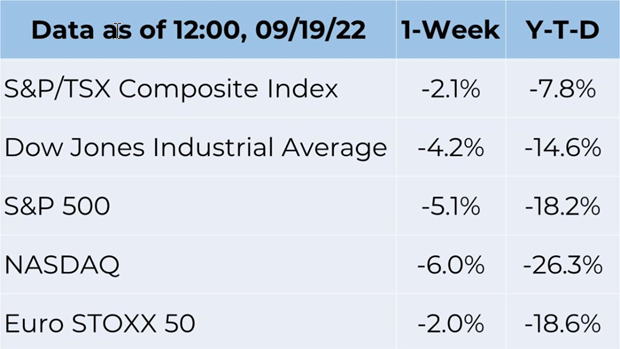Weekly Market Commentary September 22nd 2022
The Markets
Jackson Pollock was an action painter. He poured, dropped, and dripped paint onto horizontal canvases. Some people look at his work and wonder why it’s highly valued. Others find deep meaning in the paintings. Today, gauging the state of the economy is akin to interpreting abstract art.
an action painter. He poured, dropped, and dripped paint onto horizontal canvases. Some people look at his work and wonder why it’s highly valued. Others find deep meaning in the paintings. Today, gauging the state of the economy is akin to interpreting abstract art.
For example:
• Inflation is sticky. Last week’s inflation report from south of the border wasn’t everything Americans hoped it would be, especially after the Biden administration signed the “Inflation Reduction Act” into law. Overall, prices moved 8.3 percent higher in the U.S. over the 12-month period that ended in August (Statistics Canada reported 7.0 percent inflation over the same period). Core inflation, which does not include food and energy, moved higher from July to August.
• Rates have been moving higher. As they work to tame inflation, central banks have been raising the rates at a rapid pace. Some are concerned that the banks will raise rates too quickly, causing damage to their respective economies in the process.
• The manufacturing sector grew south of the border, and faltered in Canada. The Institute for Supply Management (U.S.) reported the Manufacturing Purchasing Manager’s Index (PMI) and the Services PMI showed the sector expanded for the 27th consecutive month. Readings above 50 indicate economic growth. New orders were up in August, and prices were down. By contrast, S&P Global Canada’s version of the Manufacturing PMI fell from 52.5 in July to 48.7 in August, signaling that the Canadian manufacturing sector contracted.
• Consumer optimism improved but remains low. As gasoline prices dropped, the University of Michigan’s Consumer Sentiment Index showed that (American) consumer sentiment rose to a five-month high last week. That’s not as positive as it may seem. Sentiment levels were comparable to those during the Great Recession, reported Alicia Wallace of CNN.
While economic data points are open to interpretation, one thing is for sure: many investors are not happy. Retail investors remained strongly bearish last week, according to the AAII Sentiment Survey, and institutional investors had little appetite for risk.
Major U.S. stock indices started last week with a sharp sell-off, and the S&P/TSX Composite index also finished the week lower. U.S. Treasury yields moved higher across the yield curve while Government of Canada bond yields fell slightly.
If you have any questions or concerns about recent market events, please don’t hesitate to give us a call.

Source: FactSet
Previous Event: Gardening Workshop with Brian Minter

Upcoming Event: Fundraiser Shred Event - October 15th at 9:00 A
Making Waves
Ocean waves pack a lot of power. According to the Office of Energy Efficiency and Renewable Energy, a single wave could power an electric car for hundreds of miles. And yet, when people talk about renewable energy, you don’t hear much about wave power.
Americans have been working to harness the energy of waves since the late 1800s. Christine Miller of the Western Neighborhoods Project described the excitement around wave energy in California at the turn of the 20th century.
“In December of 1881 the San Francisco News Letter ran a small article about the tremendous potential of the wave motor developed by a Californian named John W. Swailes. His invention was to be used for ‘public and private baths in this city, watering streets, flushing sewers, generating compressed air for driving machinery, also electric energy for illuminating the streets, etc. together with the last and most important purpose of extinguishing fires…’
“For two decades [1890-1910] wave motors of various designs were experimented with along Southern California's beaches…Most notable was the Starr Wave Motor of Redondo Beach which began construction in 1907. It was a large project that hoped to supply power for six counties. In the end, the enormous machine collapsed in 1909 because of the flimsy construction of the pier on which it was attached.”
Today, waves have the potential to provide about 64 percent of total U.S. electricity generation, according to the U.S. Energy Information Administration (EIA), if we can figure out how to efficiently harvest wave power. A variety of methods and technologies are being developed and tested.
Weekly Focus - Think About It
“There's nothing wrong with enjoying looking at the surface of the ocean itself, except that when you finally see what goes on underwater, you realize that you've been missing the whole point of the ocean. Staying on the surface all the time is like going to the circus and staring at the outside of the tent.”
—Dave Barry, humorist
Best regards,
Eric Muir
B.Comm. (Hons.), CIM®, FCSI
Portfolio Manager
Tracey McDonald
FCSI, DMS, CIM®
Portfolio Manager
Derek Lacroix
BBA, CIM®, CFP®
Associate Financial Advisor
P.S. Please feel free to forward this commentary to family, friends, or colleagues. If you would like us to add them to the list, please reply to this email with their email address and we will ask for their permission to be added.



